Multi-Analytical Investigation on a Renaissance Polychrome Earthenware Attributed to Giovanni Antonio Amadeo
Abstract
1. Introduction
2. Materials and Methods
2.1. The Bas-Relief
2.2. The Samples
2.3. Analytical Techniques
2.3.1. Scanning Electron Microscopy Coupled with an Energy-Dispersive X-ray Spectroscopy
2.3.2. Vibrational Spectroscopy
3. Results
3.1. Analyses of Microsamples
3.1.1. White Sample 1
3.1.2. Blue Sample 2
3.1.3. Blue Sample 3
3.1.4. Dark-Yellow Sample 4
3.1.5. Gilded Sample 5
3.1.6. Bright-Red Sample 6
3.2. In Situ Raman Measurements
4. Discussion
5. Conclusions
Author Contributions
Funding
Institutional Review Board Statement
Informed Consent Statement
Data Availability Statement
Acknowledgments
Conflicts of Interest
References
- Guglielmi, V.; Comite, V.; Andreoli, M.; Demartin, F.; Lombardi, C.A.; Fermo, P. Pigments on Roman Wall Painting and Stucco Fragments from the Monte d’Oro Area (Rome): A Multi-Technique Approach. Appl. Sci. 2020, 10, 7121. [Google Scholar] [CrossRef]
- Bonizzoni, L.; Bruni, S.; Guglielmi, V.; Milazzo, M.; Neri, O. Field and laboratory multi-technique analysis of pigments and organic painting media from an egyptian coffin (26TH dynasty). Archaeometry 2011, 53, 1212–1230. [Google Scholar] [CrossRef]
- Fermo, P.; Piazzalunga, A.; de Vos, M.; Andreoli, M. A multi-analytical approach for the study of the pigments used in the wall paintings from a building complex on the Caelian Hill (Rome). Appl. Phys. A 2013, 113, 1109–1119. [Google Scholar] [CrossRef]
- Gargano, M.; Bonizzoni, L.; Grifoni, E.; Melada, J.; Guglielmi, V.; Bruni, S.; Ludwig, N. Multi-analytical investigation of panel, pigments and varnish of The Martyirdom of St. Catherine by Gaudenzio Ferrari (16th century). J. Cult. Heritage 2020, 46, 289–297. [Google Scholar] [CrossRef]
- Westlake, P.; Siozos, P.; Philippidis, A.; Apostolaki, C.; Derham, B.; Terlixi, A.; Perdikatsis, V.; Jones, R.; Anglos, D. Studying pigments on painted plaster in Minoan, Roman and Early Byzantine Crete. A multi-analytical technique approach. Anal. Bioanal. Chem. 2011, 402, 1413–1432. [Google Scholar] [CrossRef]
- Barni, M.; Pelagotti, A.; Piva, A. Image processing for the analysis and conservation of paintings: Opportunities and challenges. IEEE Signal Process. Mag. 2005, 22, 141–144. [Google Scholar] [CrossRef]
- Bonizzoni, L.; Bruni, S.; Gargano, M.; Guglielmi, V.; Zaffino, C.; Pezzotta, A.; Pilato, A.; Auricchio, T.; Delvaux, L.; Ludwig, N. Use of integrated non-invasive analyses for pigment characterization and indirect dating of old restorations on one Egyptian coffin of the XXI dynasty. Microchem. J. 2018, 138, 122–131. [Google Scholar] [CrossRef]
- Lombardi, C.A.; Comite, V.; Fermo, P.; Bergomi, A.; Trombino, L.; Guglielmi, V. A Multi-Analytical Approach for the Characterisation of Pigments from an Egyptian Sarcophagus Cover of the Late Dynastic Period: A Case Study. Sustainability 2023, 15, 2002. [Google Scholar] [CrossRef]
- Fiocco, G.; Albano, M.; Merlo, C.; Rovetta, T.; Lee, C.; Volpi, F.; Bergomi, A.; Pini, C.; Lombardi, C.A.; Mariani, C.; et al. Non-Invasive Characterization of Bernardino Luini’s Color Palette: A Spectroscopic Campaign on the Frescos of Santuario Della Beata Vergine Dei Miracoli in Saronno (Italy). In Proceedings of the 2022 IMEKO TC-4 International Conference on Metrology for Archaeology and Cultural Heritage, Cosenza, Italy, 19–21 October 2022. [Google Scholar]
- Burgio, L.; Clark, R.J.H. Comparative Pigment Analysis of Six Modern Egyptian Papyri and an Authentic One of the 13th Century BC by Raman Microscopy Other Techniques. J. Raman Spectrosc. 2000, 31, 395–401. [Google Scholar] [CrossRef]
- Bednarik, R.G. Direct Dating of Chinese Immovable Cultural Heritage. Quaternary 2021, 4, 42. [Google Scholar] [CrossRef]
- Fermo, P.; Colella, M.; Malagodi, M.; Fiocco, G.; Albano, M.; Marchioron, S.; Guglielmi, V.; Comite, V. Study of a surface coating present on a Renaissance Piety from the Museum of Ancient Art (Castello Sforzesco, Milan). Environ. Sci. Pollut. Res. 2021, 29, 29498–29509. [Google Scholar] [CrossRef] [PubMed]
- Bruni, S.; Guglielmi, V.; Della Foglia, E.; Castoldi, M.; Gianni, G.B. A non-destructive spectroscopic study of the decoration of archaeological pottery: From matt-painted bichrome ceramic sherds (southern Italy, VIII-VII B.C.) to an intact Etruscan cinerary urn. Spectrochim. Acta Part A Mol. Biomol. Spectrosc. 2018, 191, 88–97. [Google Scholar] [CrossRef] [PubMed]
- Pessanha, S.; Guiherme, A.; Manso, M.; de Carvalho, M.L. X-Ray fluorescence applications to art and cultural heritage: Study of a Japanese print. Environ. Sci. Pollut. Res. 2008, 20, 9–11. [Google Scholar]
- Comite, V.; Andreoli, M.; Atzei, D.; Barca, D.; Fantauzzi, M.; La Russa, M.F.; Rossi, A.; Guglielmi, V.; Fermo, P. Degradation Products on Byzantine Glasses from Northern Tunisia. Appl. Sci. 2020, 10, 7523. [Google Scholar] [CrossRef]
- Zaffino, C.; Russo, B.; Bruni, S. Surface-enhanced Raman scattering (SERS) study of anthocyanidins. Spectrochim. Acta Part A Mol. Biomol. Spectrosc. 2015, 149, 41–47. [Google Scholar] [CrossRef]
- Zaffino, C.; Bruni, S.; Russo, B.; Pilu, R.; Lago, C.; Colonna, G.M. Identification of anthocyanins in plant sources and textiles by surface-enhanced Raman spectroscopy (SERS). J. Raman Spectrosc. 2015, 47, 269–276. [Google Scholar] [CrossRef]
- Daniels, V.; Stacey, R.; Middleton, A. The Blackening of Paint Containing Egyptian Blue. Stud. Conserv. 2004, 49, 217–230. [Google Scholar]
- Li, Z.; Wang, L.; Chen, H.; Ma, Q. Degradation of emerald green: Scientific studies on multi-polychrome Vairocana Statue in Dazu Rock Carvings, Chongqing, China. Heritage Sci. 2020, 8, 1–12. [Google Scholar] [CrossRef]
- Mezzabotta, P. Giovanni Antonio Amadeo e La Tecnica Della Terracotta. La Madonna Col Bambino, Santa Caterina Da Siena e un Monaco Certosino, La Versione Del Museo d’Arte Antica del Castello Sforzesco e Quella Proveniente Da Una Collezione Privata. Analisi scientifica e storia collezionistica. Master’s Thesis, Università degli Studi di Milano, Milan, Italy, 2021. [Google Scholar]
- Cavazzini, L., II. Giovane Amadeo e La Terracotta; Terracotte Del Ducato Di Milano: Milan, Italy, 2011. [Google Scholar]
- Barreca, S.; Bruno, M.; Oddo, L.; Orecchio, S. Preliminary study on analysis and removal of wax from a Carrara marble statue. Nat. Prod. Res. 2019, 33, 947–955. [Google Scholar] [CrossRef]
- Ciofini, D.; Oujja, M.; Cañamares, M.V.; Siano, S.; Castillejo, M. Detecting molecular changes in UV laser-ablated oil/diterpenoid resin coatings using micro-Raman spectroscopy and Laser Induced Fluorescence. Microchem. J. 2018, 141, 12–24. [Google Scholar] [CrossRef]
- Ashok, R. Artists’ Pigments A Handbook of Their History and Characteristics; National Gallery of Art: Washington, DC, USA, 2012; Volume 2. [Google Scholar]
- Feller, R.L. Artists’ Pigments, A Handbook of Their History and Characteristics; National Gallery of Art: Washington, DC, USA, 2012; Volume 1. [Google Scholar]
- FitzHugh, E.W. Artists’ Pigments, A Handbook of Their History and Characteristics; National Gallery of Art: Washington, DC, USA, 2012; Volume 3. [Google Scholar]
- Madariaga, J.M. Analytical chemistry in the field of cultural heritage. Anal. Methods 2015, 7, 4848–4876. [Google Scholar] [CrossRef]
- Bruni, S.; Cariati, F.; Casadio, F.; Toniolo, L. Spectrochemical characterization by micro-FTIR spectroscopy of blue pigments in different polychrome works of art. Vib. Spectrosc. 1999, 20, 15–25. [Google Scholar] [CrossRef]
- Burgio, L.; Clark, R.J.H. Library of FT-Raman Spectra of Pigments, Minerals, Pigment Media and Varnishes, and Supplement to Existing Library of Raman Spectra of Pigments with Visible Excitation. Spectrochim. Acta Part A 2001, 57, 1491–1521. [Google Scholar] [CrossRef] [PubMed]
- Nodari, L.; Ricciardi, P. Non-invasive identification of paint binders in illuminated manuscripts by ER-FTIR spectroscopy: A systematic study of the influence of different pigments on the binders’ characteristic spectral features. Herit. Sci. 2019, 7, 7. [Google Scholar] [CrossRef]
- Edwards, H.G.M.; Villar, S.E.J.; Eremin, K.A. Raman spectroscopic analysis of pigments from dynastic Egyptian funerary artefacts. J. Raman Spectrosc. 2004, 35, 786–795. [Google Scholar] [CrossRef]
- Bell, I.M.; Clark, R.J.H.; Gibbs, P.J. Raman Spectroscopic Library of Natural and Synthetic Pigments (Pre-1850 AD). Spectrochim. Part A 1997, 53, 2159–2179. [Google Scholar] [CrossRef]
- Vandenabeele, P.; Garcia-Moreno, R.; Mathis, F.; Leterme, K.; Van Elslande, E.; Hocquet, F.-P.; Rakkaa, S.; Laboury, D.; Moens, L.; Strivay, D.; et al. Multi-disciplinary investigation of the tomb of Menna (TT69), Theban Necropolis, Egypt. Spectrochim. Acta Part A Mol. Biomol. Spectrosc. 2009, 73, 546–552. [Google Scholar] [CrossRef]
- Clark, R.J.H. Pigment identification by spectroscopic means: An arts/science interface. Comptes Rendus Chim. 2002, 5, 7–20. [Google Scholar] [CrossRef]
- Kock, L.D.; De Waal, D. Raman analysis of ancient pigments on a tile from the Citadel of Algiers. Spectrochim. Acta Part A Mol. Biomol. Spectrosc. 2008, 71, 1348–1354. [Google Scholar] [CrossRef]
- Bonizzoni, L.; Bruni, S.; Galli, A.; Gargano, M.; Guglielmi, V.; Ludwig, N.; Lodi, L.; Martini, M. Non-invasive in situ analytical techniques working in synergy: The application on graduals held in the Certosa di Pavia. Microchem. J. 2016, 126, 172–180. [Google Scholar] [CrossRef]
- Venuti, V.; Caridi, F.; Colica, E.; Crupi, V.; D’Amico, S.; Guido, S.; Majolino, D.; Paladini, G.; Mantella, G. Diagnostic Investigation of the Cycle of the New Church of Sarria (Floriana, Malta) by Mattia Preti. Proc. J. Phys. Conf. Ser. Inst. Phys. 2022, 2204, 012023. [Google Scholar] [CrossRef]
- Guglielmi, V.; Andreoli, M.; Comite, V.; Baroni, A.; Fermo, P. The combined use of SEM-EDX, Raman, ATR-FTIR and visible reflectance techniques for the characterisation of Roman wall painting pigments from Monte d’Oro area (Rome): An insight into red, yellow and pink shades. Environ. Sci. Pollut. Res. 2022, 29, 29419–29437. [Google Scholar] [CrossRef]
- Cappelletti, G.; Ardizzone, S.; Fermo, P.; Gilardoni, S. The influence of iron content on the promotion of the zircon structure and the optical properties of pink coral pigments. J. Eur. Ceram. Soc. 2005, 25, 911–917. [Google Scholar] [CrossRef]
- Vahur, S.; Teearu, A.; Peets, P.; Joosu, L.; Leito, I. ATR-FT-IR spectral collection of conservation materials in the extended region of 4000-80 cm–1. Anal. Bioanal. Chem. 2016, 408, 3373–3379. [Google Scholar] [CrossRef] [PubMed]
- Harroun, S.G.; Bergman, J.; Jablonski, E.; Brosseau, C.L. Surface-enhanced Raman spectroscopy analysis of house paint and wallpaper samples from an 18th century historic property. Analyst 2011, 136, 3453–3460. [Google Scholar] [CrossRef] [PubMed]
- Matteini, M.; Moles, A. La Chimica Del Restauro; Nardini Editore: Firenze, Italy, 2004. [Google Scholar]
- Campanella, L.; Casoli, A.; Colombini, M.P.; Marini Bettolo, R.; Matteini, M.; Migneco, L.M.; Montenero, A.; Nodari, L.; Piccioli, C.; Plossi Zappalà, M.; et al. Chimica Per L’arte; Zanichelli: Bologna, Italy, 2011. [Google Scholar]
- Database of ATR-FT-IR Spectra of Various Materials. Available online: https://Spectra.Chem.Ut.Ee/Paint/Pigments/Lead-White/ (accessed on 27 January 2023).
- Pellegrini, D.; Duce, C.; Bonaduce, I.; Biagi, S.; Ghezzi, L.; Colombini, M.P.; Tinè, M.R.; Bramanti, E. Fourier transform infrared spectroscopic study of rabbit glue/inorganic pigments mixtures in fresh and aged reference paint reconstructions. Microchem. J. 2016, 124, 31–35. [Google Scholar] [CrossRef]
- Chukanov, N.V.; Chervonnyi, A.D. Infrared Spectroscopy of Minerals and Related Compounds; Springer: Berlino, Germany, 2016. [Google Scholar]
- Chukanov, N.V. Infrared Spectra of Mineral Species, 3rd ed.; Springer: Berlino, Germany, 2014; pp. 14–1726. [Google Scholar] [CrossRef]
- Gadsden, J.A. Infrared Spectra of Mineral and Related Inorganic Compounds; Butterworths: London, UK, 1975. [Google Scholar]
- Derrick, M.R.; Stulik, D.; Landry, J.M. Scientific Tools for Conservation Infrared S Pectrosco p y in Conservation Science; The Getty Conservation Institute: Los Angeles, CA, USA, 1999. [Google Scholar]
- Cavallo, G.; Riccardi, M.P. Glass-based pigments in painting: Smalt blue and lead–tin yellow type II. Archaeol. Anthr. Sci. 2021, 13, 13. [Google Scholar] [CrossRef]
- Jones, G.C.; Jackson, B. Infrared Transmission Spectra of Carbonate Minerals; Springer: Dordrecht, The Netherlands, 1993. [Google Scholar]
- Franquelo, M.L.; Duran, A.; Herrera, L.K.; Jimenez de Haro, M.C.; Perez-Rodriguez, J.L. Comparison between micro-Raman and micro-FTIR spectroscopy techniques for the characterization of pigments from Southern Spain Cultural Heritage. J. Mol. Struct. 2009, 924-926, 404–412. [Google Scholar] [CrossRef]
- Database of ATR-FT-IR Spectra of Various Materials. Available online: https://Spectra.Chem.Ut.Ee/Paint/Pigments/Prussian-Blue/ (accessed on 27 January 2023).
- Doménech-Carbó, A.; Doménech-Carbó, M.T.; Osete-Cortina, L.; Donnici, M.; Guasch-Ferré, N.; Gasol-Fargas, R.M.; Iglesias-Campos, M. Electrochemical assessment of pigments-binding medium interactions in oil paint deterioration: A case study on indigo and Prussian blue. Heritage Sci. 2020, 8, 1–17. [Google Scholar] [CrossRef]
- Scott, D.A. Copper and Bronze in Art: Corrosion, Colorants, Conservation; Getty Trust Publications: Los Angeles, CA, USA, 2002; pp. 253–255. [Google Scholar]
- Bianucci, R.; Mattutino, G.; Lallo, R.; Torre, C. Identification of a chrysocolla amulet in an Early Dynastic child mummy. J. Archaeol. Sci. 2009, 36, 592–595. [Google Scholar] [CrossRef]
- Mugnaini, S.; Bagnoli, A.; Bensi, P.; Droghini, F.; Scala, A.; Guasparri, G. Thirteenth century wall paintings under the Siena Cathedral (Italy). Mineralogical and petrographic study of materials, painting techniques and state of conservation. J. Cult. Heritage 2006, 7, 171–185. [Google Scholar] [CrossRef]
- Andersen, F.A.; Brecevic, L. Infrared Spectra of Amorphous and Crystalline Calcium Carbonate. Acta Chem. Scand. 1991, 45, 1018–1024. [Google Scholar] [CrossRef]
- IRUG-Infrared Raman Users Group. Available online: http://www.irug.org (accessed on 27 January 2023).
- Bevilacqua, N.; Borgioli, L.; Adrover Gracia, I. I Pigmenti Nell’arte: Dalla Preistoria Alla Rivoluzione Industriale; il Prato Publishing House: Saonara, Italy, 2010. [Google Scholar]
- Bikiaris, D.; Daniilia, S.; Sotiropoulou, S.; Katsimbiri, O.; Pavlidou, E.; Moutsatsou, A.; Chryssoulakis, Y. Ochre-differentiation through micro-Raman and micro-FTIR spectroscopies: Application on wall paintings at Meteora and Mount Athos, Greece. Spectrochim. Acta A Mol. Biomol. Spectrosc. 1999, 56, 3–18. [Google Scholar] [CrossRef]
- Di Lernia, S.; Bruni, S.; Cislaghi, I.; Cremaschi, M.; Gallinaro, M.; Guglielmi, V.; Mercuri, A.M.; Poggi, G.; Zerboni, A. Colour in context. Pigments and other coloured residues from the Early-Middle Holocene site of Takarkori (SW Libya). Archaeol. Anthr. Sci. 2016, 8, 381–402. [Google Scholar] [CrossRef]
- Vahur, S.; Teearu, A.; Leito, I. ATR-FT-IR spectroscopy in the region of 550–230 cm−1 for identification of inorganic pigments. Spectrochim. Acta Part A Mol. Biomol. Spectrosc. 2010, 75, 1061–1072. [Google Scholar] [CrossRef]
- Domingo, I.; García-Borja, P.; Roldán, C. Identification, processing and use of red pigments (hematite and cinnabar) in the valencian early neolithic (Spain). Archaeometry 2012, 54, 868–892. [Google Scholar] [CrossRef]
- Invernizzi, C.; Daveri, A.; Vagnini, M.; Malagodi, M. Non-invasive identification of organic materials in historical stringed musical instruments by reflection infrared spectroscopy: A methodological approach. Anal. Bioanal. Chem. 2017, 409, 3281–3288. [Google Scholar] [CrossRef]
- Shukshin, V.E.; Fedorov, P.P.; Generalov, M.E. Low-Frequency Raman Lines as an Indicator of the Presence of Lead in Oxide Materials. Russ. J. Inorg. Chem. 2019, 64, 1442–1445. [Google Scholar] [CrossRef]
- Pargoletti, E.; Tricoli, A.; Pifferi, V.; Orsini, S.; Longhi, M.; Guglielmi, V.; Cerrato, G.; Falciola, L.; Derudi, M.; Cappelletti, G. An electrochemical outlook upon the gaseous ethanol sensing by graphene oxide-SnO2 hybrid materials. Appl. Surf. Sci. 2019, 483, 1081–1089. [Google Scholar] [CrossRef]
- Tomasini, E.P.; Halac, E.B.; Reinoso, M.; di Liscia, E.J.; Maier, M.S. Micro-Raman Spectroscopy of Carbon-Based Black Pigments. J. Raman Spectrosc. 2012, 43, 1671–1675. [Google Scholar] [CrossRef]
- Correia, A.M.; Clark, R.J.H.; Ribeiro, M.I.M.; Duarte, M.L.T.S. Pigment study by Raman microscopy of 23 paintings by the Portuguese artist Henrique Pousão (1859–1884). J. Raman Spectrosc. 2007, 38, 1390–1405. [Google Scholar] [CrossRef]
- Grandjean, F.; Samain, L.; Long, G.J. Characterization and utilization of Prussian blue and its pigments. Dalton Trans. 2016, 45, 18018–18044. [Google Scholar] [CrossRef] [PubMed]
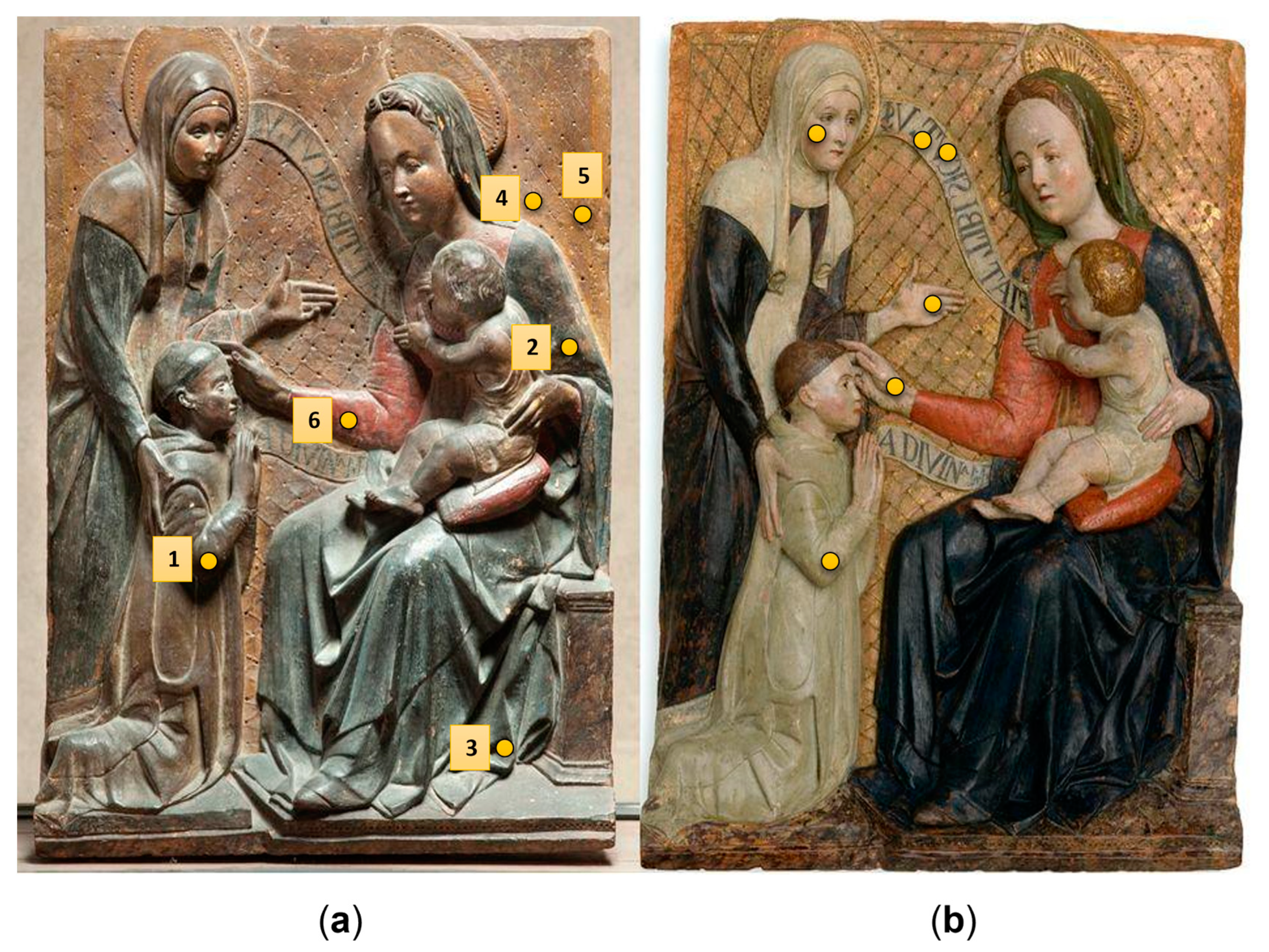
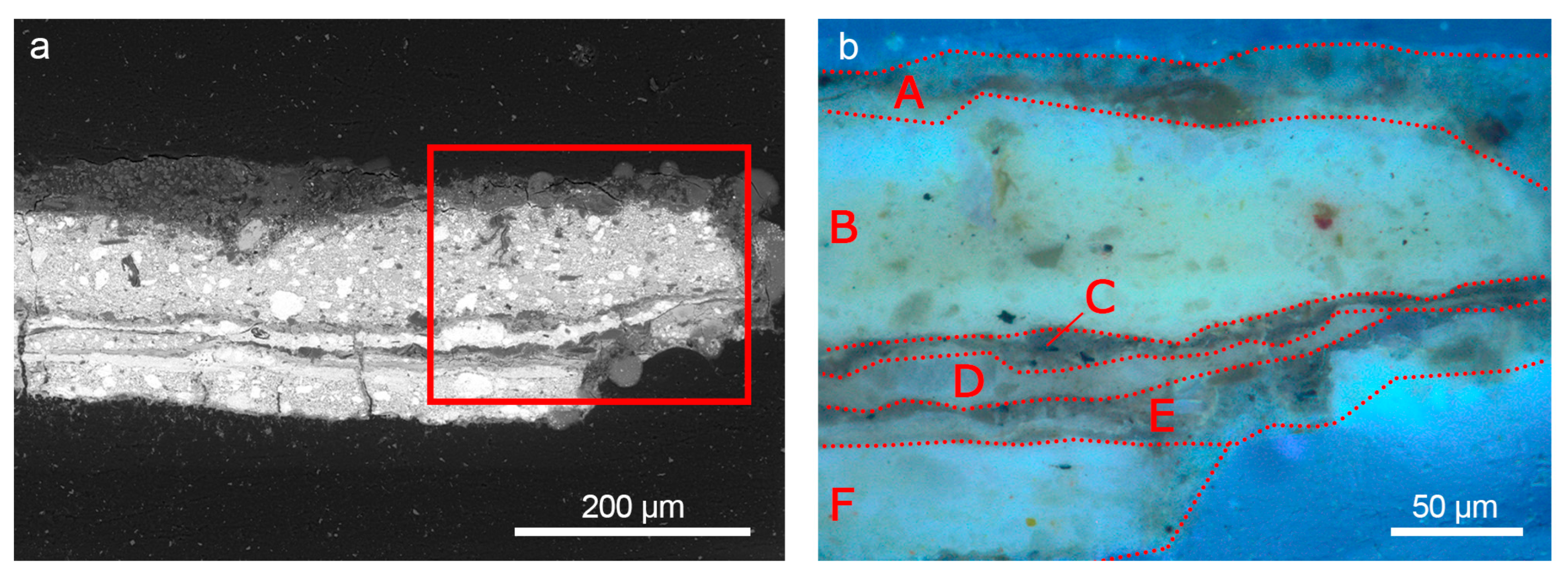
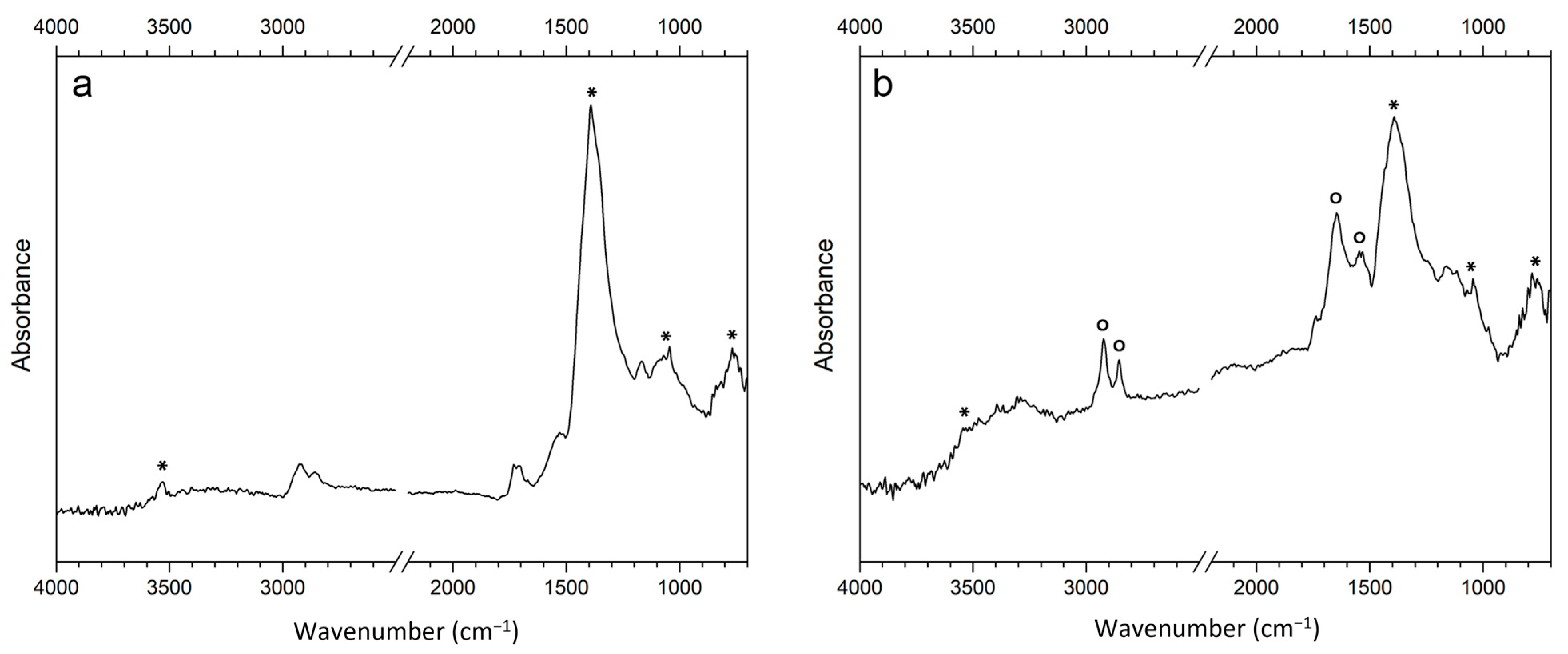

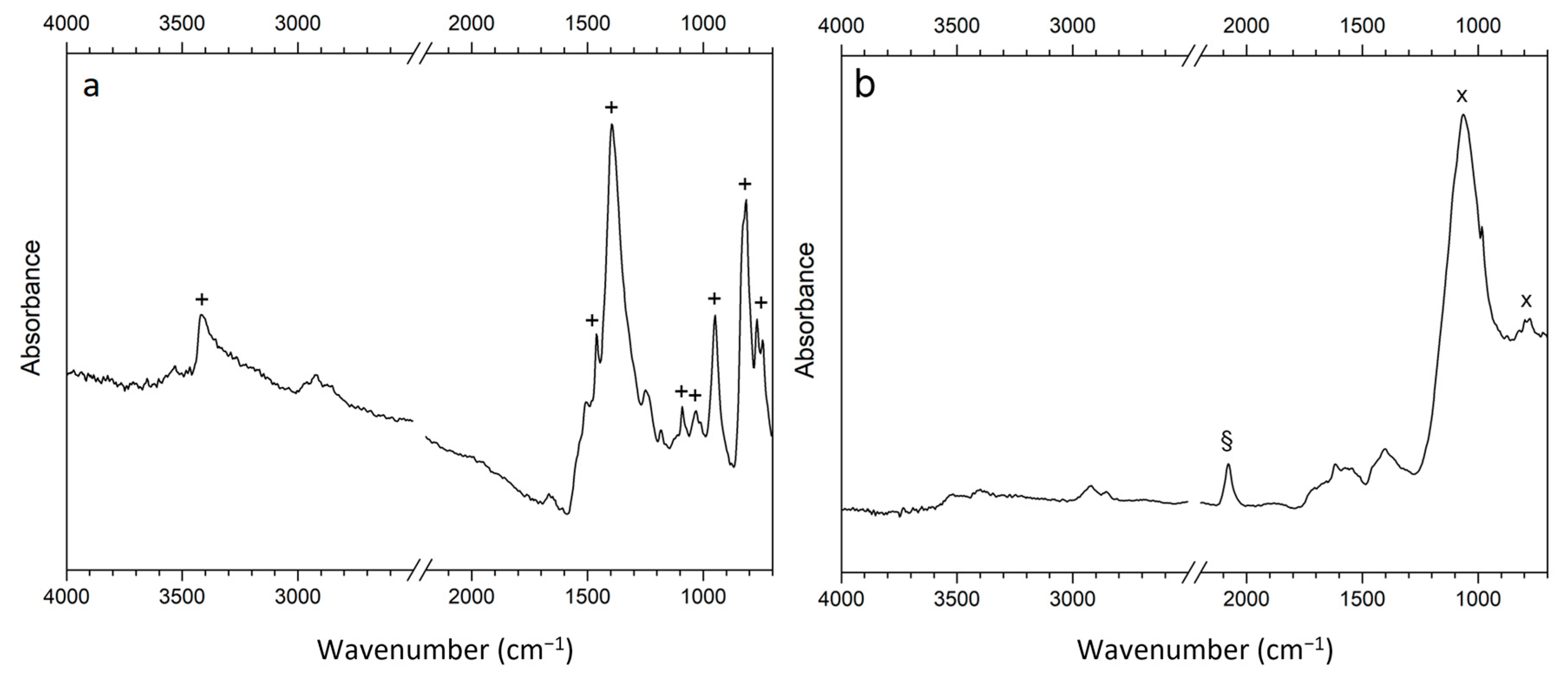
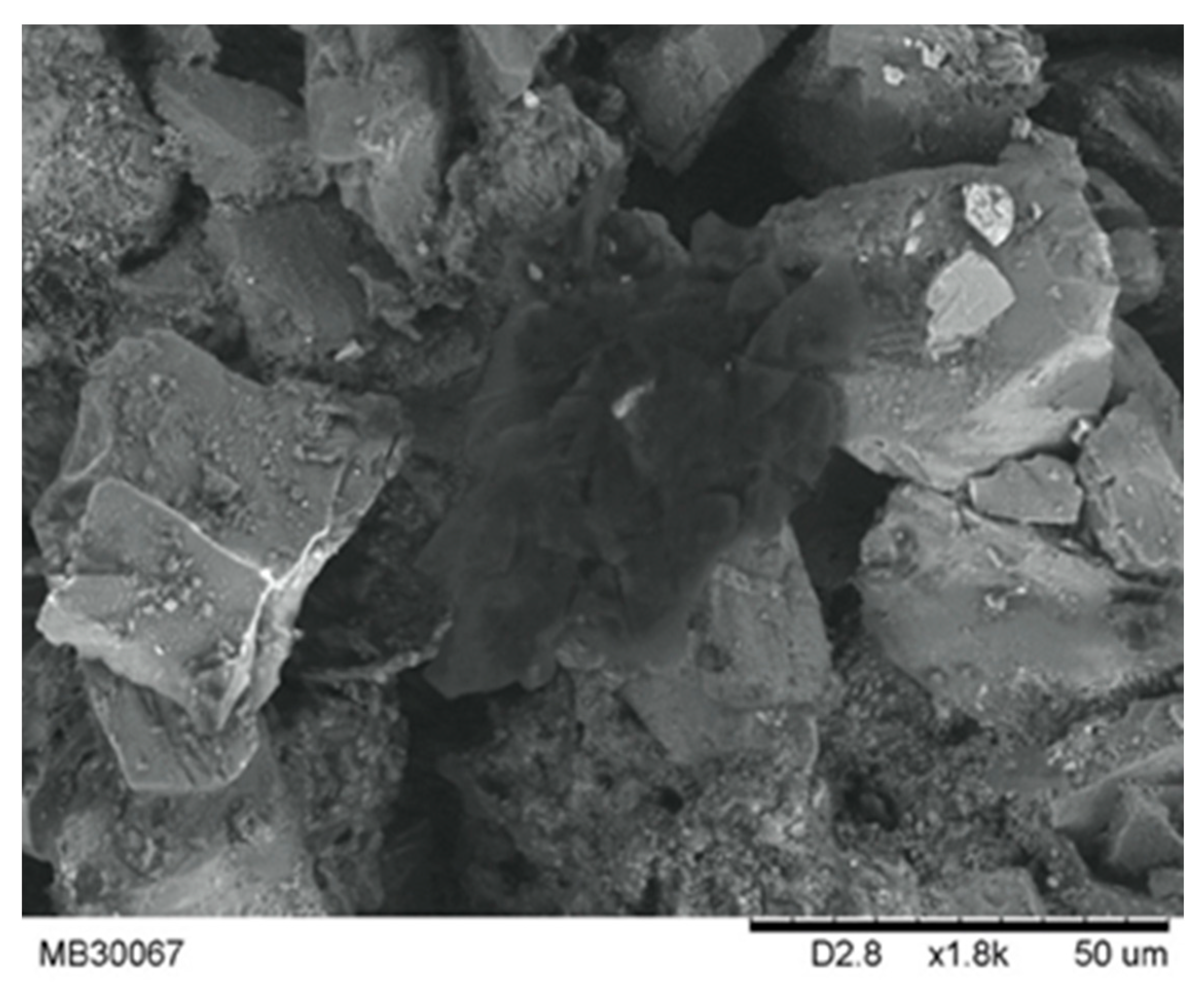

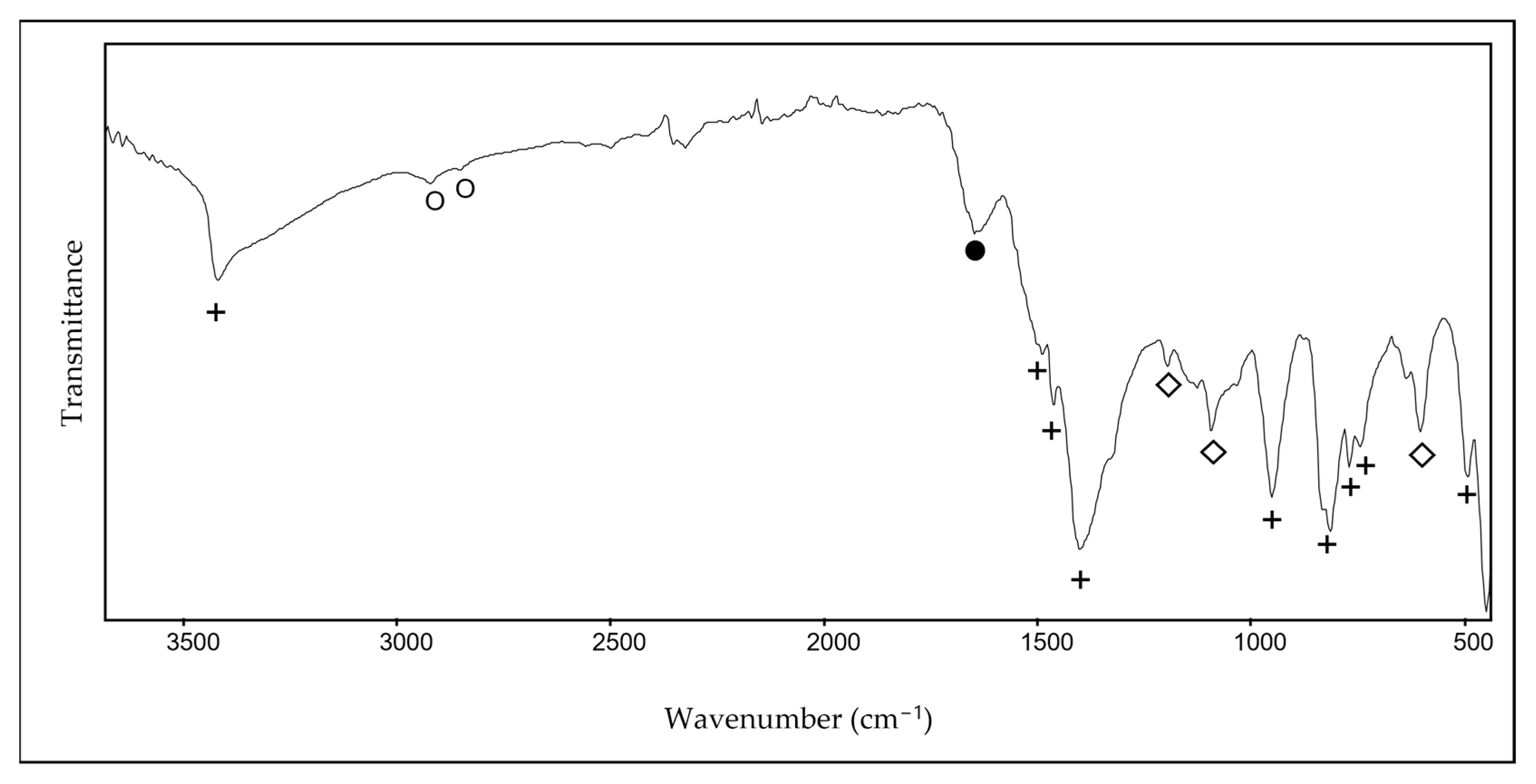

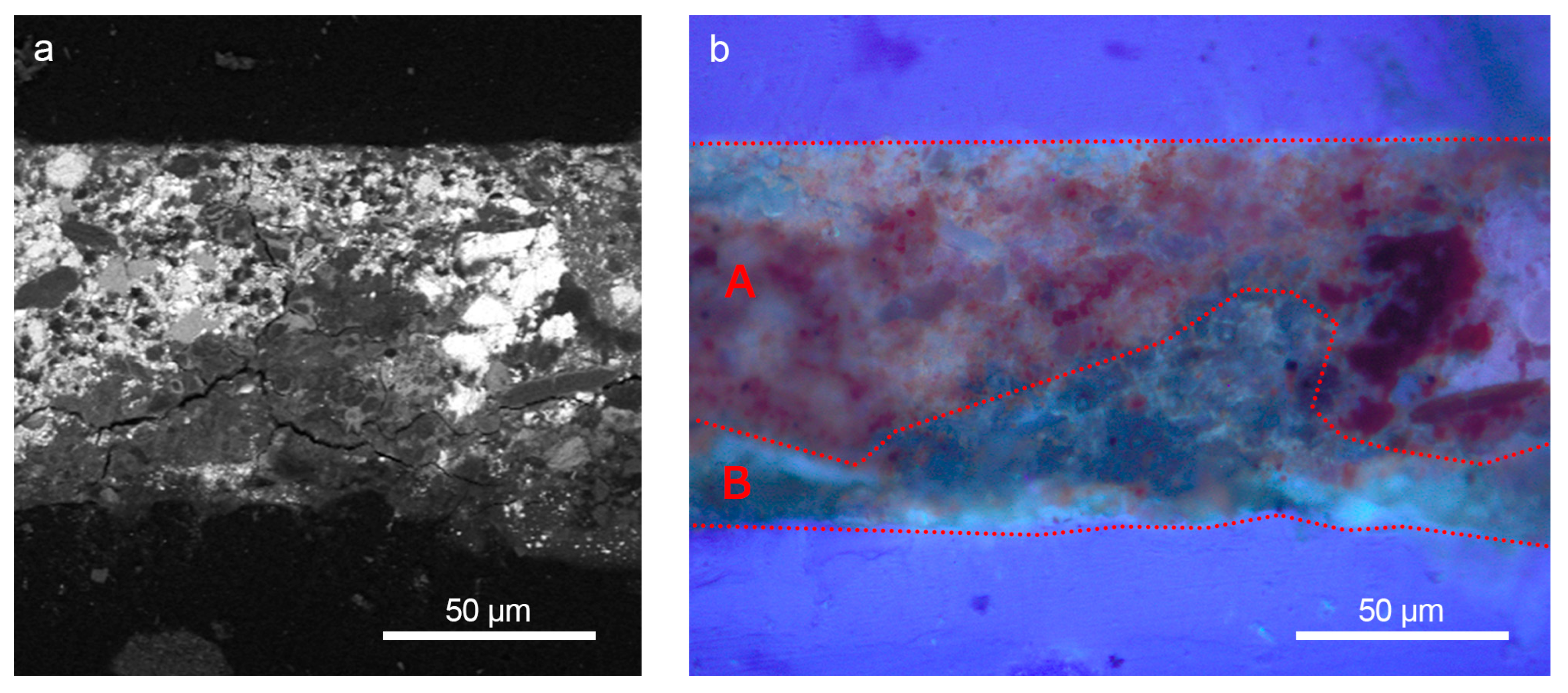
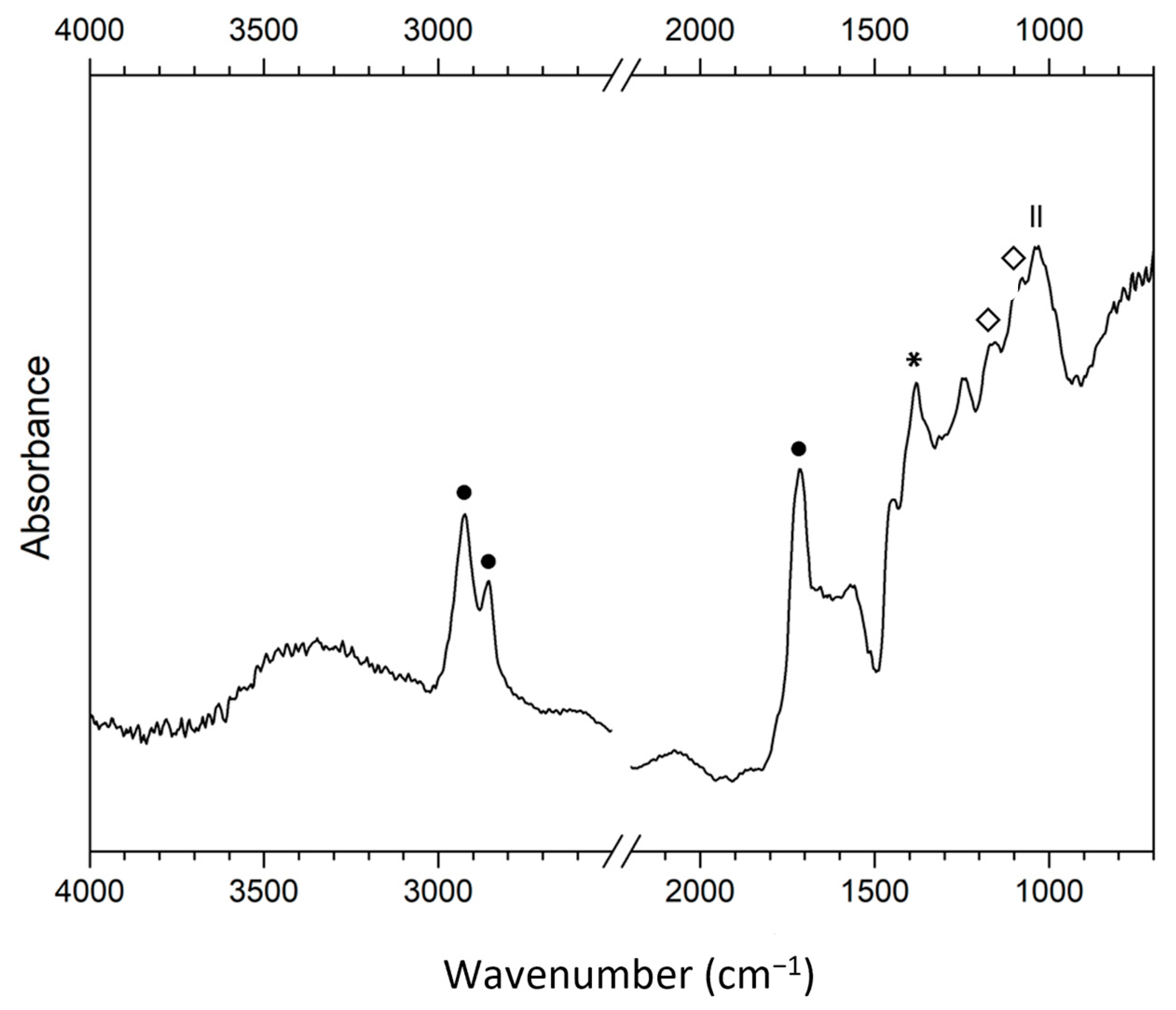
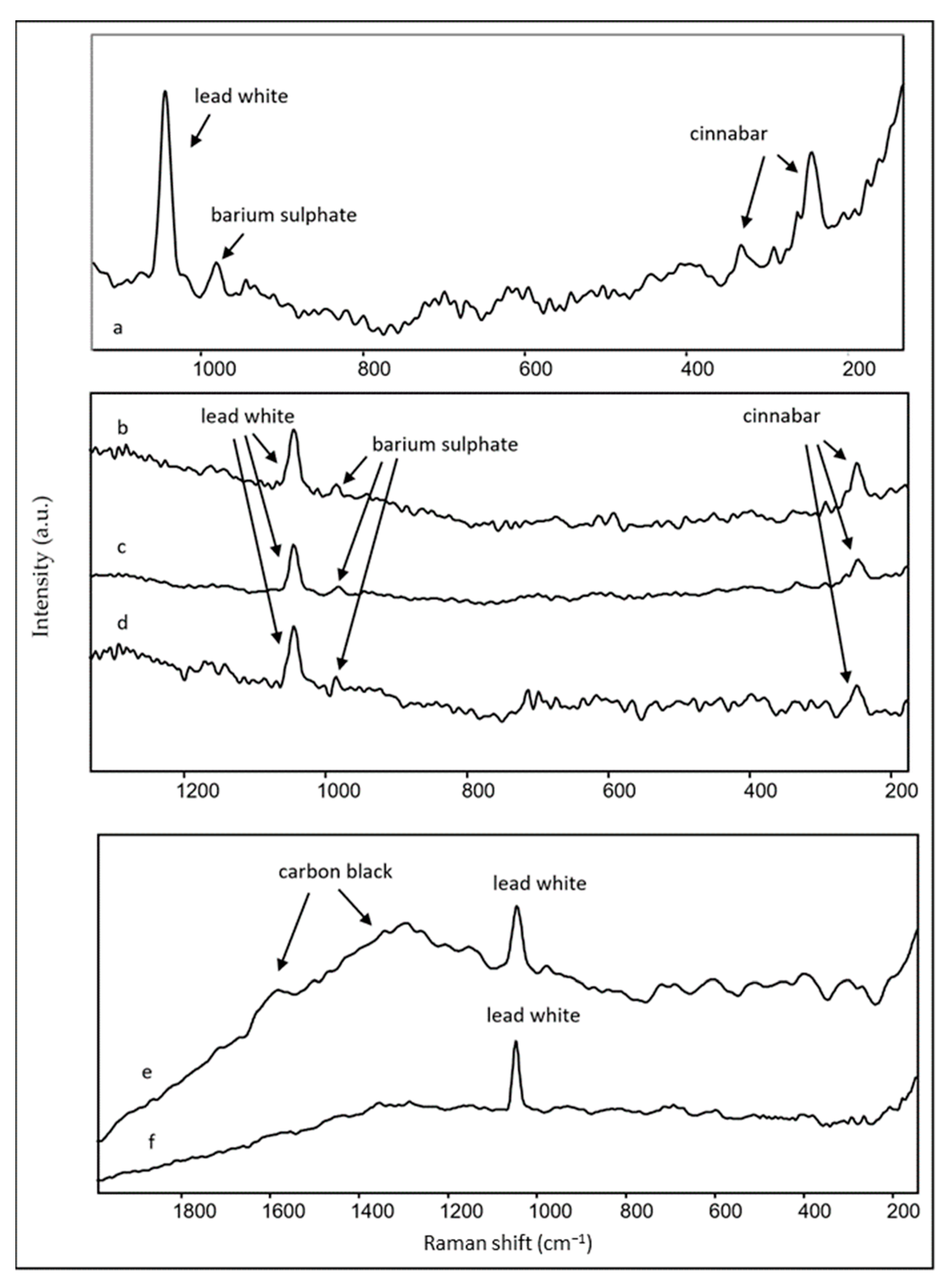
| Sample | Layer | Colour | SEM-EDS (Characterising Elements) | ATR-FTIR (Peaks, cm−1) | Composition |
|---|---|---|---|---|---|
| 1 | A | white/grey | Ca, Si | 2930, 2860, 1650, 1550, ~1400 (br), ~1000 (br), 873 | calcite, silicate, proteinaceous compound |
| B | white | Pb | 3435, 1400, 1045, 770 | biacca | |
| C | white/grey | Ca, Si | ~1400 (br), ~1000 (br), 873 | calcite, silicate | |
| D | whitish | Ba | 1180, 1120 (sh), 1085, 985 | barite | |
| E | white/grey | Ca, Si | 2930, 2860, 1650, 1550 | calcite, proteinaceous compound | |
| F | white | Pb | 3435, 1400, 1045, 770 | biacca | |
| 2 | A | white/grey | Ca, Ba, S | 1410, 1180, 1110, 1060 | Calcite, barite |
| B | white | Pb | 2930, 2860, 1650, 1550, 1400 | biacca and proteinaceous material | |
| C | blue | Fe, Co, | 2080 (PB), 1060, 790 | smaltino and Prussian blue | |
| D | blue | Cu | 3420, 1465, 1090, 1026, 1400, 950, 820 | Azurite | |
| 3 | - | blue | Cu, Ba, S | 3425, 1492, 1463, 1412, 952, 833, 815, 770, 740, 490, 446 1185, 1080, 635, 603 | Azurite, Barite |
| 4 | - | dark yellow | Fe, Si, K, Al, Pb, Ca | 1393 (br), 678 2920, 2849, 1651, 1550 1318, 1088, 1032, 913, 798, 779, 530, 470, 3325, 3400, 1460, 667, 598,874, 713 | Lead white, yellow ochre |
| 5 | - | gold | Au, Si, Al, Pb, Ca, S, Ba | 1400, 874,713 1185, 1080, 635, 603 (ba), 1088, 1032, 913, 798, 779, 1393 (br), 678 (lw) | Gold, Lead white, Calcite, Barite, silicate |
| 6 | A | red | Hg, Pb, Ba, S | 2925, 2860, 1715, 1390, 1180, 1060, 1400, 678 | Cinnabar, lead white, barite, organic material |
| B | white/grey | Ca | ~1400, 870 | Calcite |
Disclaimer/Publisher’s Note: The statements, opinions and data contained in all publications are solely those of the individual author(s) and contributor(s) and not of MDPI and/or the editor(s). MDPI and/or the editor(s) disclaim responsibility for any injury to people or property resulting from any ideas, methods, instructions or products referred to in the content. |
© 2023 by the authors. Licensee MDPI, Basel, Switzerland. This article is an open access article distributed under the terms and conditions of the Creative Commons Attribution (CC BY) license (https://creativecommons.org/licenses/by/4.0/).
Share and Cite
Guglielmi, V.; Lombardi, C.A.; Fiocco, G.; Comite, V.; Bergomi, A.; Borelli, M.; Azzarone, M.; Malagodi, M.; Colella, M.; Fermo, P. Multi-Analytical Investigation on a Renaissance Polychrome Earthenware Attributed to Giovanni Antonio Amadeo. Appl. Sci. 2023, 13, 3924. https://doi.org/10.3390/app13063924
Guglielmi V, Lombardi CA, Fiocco G, Comite V, Bergomi A, Borelli M, Azzarone M, Malagodi M, Colella M, Fermo P. Multi-Analytical Investigation on a Renaissance Polychrome Earthenware Attributed to Giovanni Antonio Amadeo. Applied Sciences. 2023; 13(6):3924. https://doi.org/10.3390/app13063924
Chicago/Turabian StyleGuglielmi, Vittoria, Chiara Andrea Lombardi, Giacomo Fiocco, Valeria Comite, Andrea Bergomi, Mattia Borelli, Monica Azzarone, Marco Malagodi, Mario Colella, and Paola Fermo. 2023. "Multi-Analytical Investigation on a Renaissance Polychrome Earthenware Attributed to Giovanni Antonio Amadeo" Applied Sciences 13, no. 6: 3924. https://doi.org/10.3390/app13063924
APA StyleGuglielmi, V., Lombardi, C. A., Fiocco, G., Comite, V., Bergomi, A., Borelli, M., Azzarone, M., Malagodi, M., Colella, M., & Fermo, P. (2023). Multi-Analytical Investigation on a Renaissance Polychrome Earthenware Attributed to Giovanni Antonio Amadeo. Applied Sciences, 13(6), 3924. https://doi.org/10.3390/app13063924














